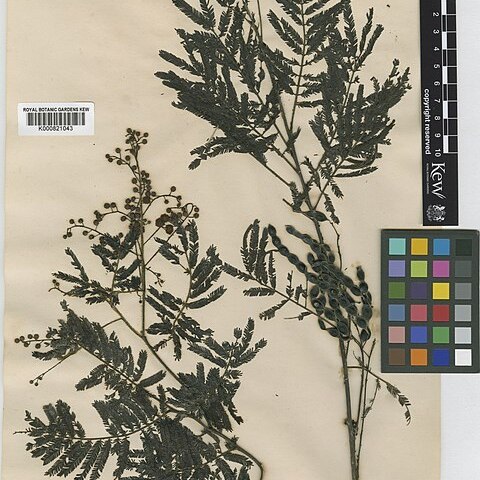Erect, often diffuse shrub or tree to 15 m high. Bark smooth or slightly fissured, green, grey or brown. Branchlets terete, slightly angled or flattened towards apices, with yellowish pilose hairs especially on ridges, the branchlet tips often pendulous. Young foliage-tips fawn, yellowish or golden-brown, densely pilose. Leaves bipinnate, sometimes ± sessile; petiole to 0.3 (–0.5) cm long above the pulvinus (often obscure with basal pair of pinnae arising from near pulvinus), mostly with an oval to circular gland at base of or near lowest pair of pinnae; rachis (2.5–) 5–12 cm long, narrowly ridged above, with hairs similar to those on branchlets, with a circular, oval or oblong-oval gland gland just below to half-way between the uppermost 1–10 pairs of pinnae (usually jugary at apex while other glands often interjugary); pinnae 7–20 (–27) pairs, 1–4.7 cm long, with lowermost pair slightly shorter than others, down-curved; pinnules dark green above, paler beneath, 14–40 (–51) pairs, oblong to narrowly oblong, (1–) 1.5–4 (–5) mm long, 0.5–0.8 (–1) mm wide, glabrous, apex obtuse or acute. Inflorescences in axillary racemes, or terminal or axillary false-panicles; peduncles 3–5 mm long, glabrous. Heads globular, 12–25-flowered, pale yellow or cream-coloured. Pods straight to curved, ± straight-sided to variably constricted between seeds, ± flat or slightly raised over seeds, 3–14 cm long, 7–12 mm wide, coriaceous, brownish black or blue-black, veined, pilose along the margin when young.
More
An evergreen tree. It grows to 10-20 m high and 3-10 m across. The stem is erect. The branches hang down. They are covered with brown hairs. The leaves (phyllodes) are light green and finely divided. They have a feather-like appearance. The larger leaf parts are in 11-18 pairs and these are 2-5 cm long. The secondary leaflets have 15-40 pairs and these are 0.4-0.6 cm by 0.1-0.3 cm. They are dark green above and pale green underneath. The leaf stalk is long and rigid. The leaf can be 12 cm long. The flowers are light yellow balls. They occur in large clusters at the ends of branches. The pods are brown. They can be 10-15 cm long and 1 cm wide. They are flat and hard and leathery.


